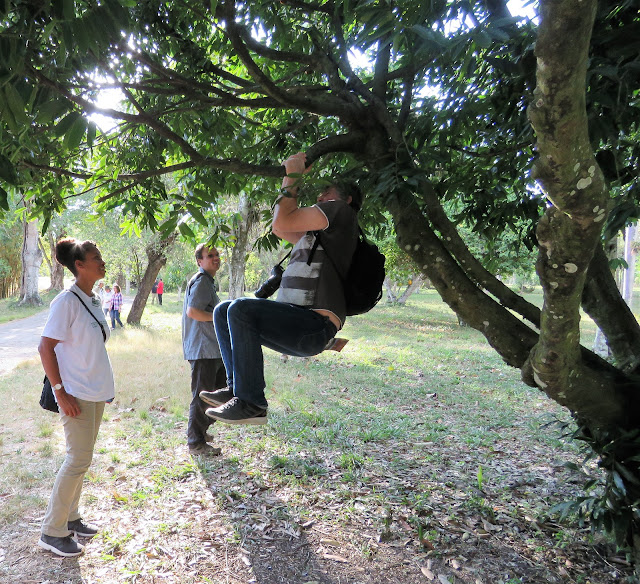Persimmon-like fruits and others swing on ebony branch
I don't recommend doing this at home. In most botanic gardens, it is definitely not allowed. But, if you and a few mates are going to swing from tree branch, you should chose an ebony.
Under instruction by our guide at Jardín Botánico de Cienfuegos, in Cuba, three people ended up swinging from this particular branch, and it didn't break. I stopped photographing at two, just in case.
Ebony has an almost fabled reputation as a tough wood. Diospyros ebenum, the subcontinental species traditionally harvested and farmed for this timber, has black and heavy wood. Almost too hard to nail they say. With a grain so fine it can be polished as smooth as ... ebony.
Clarinets and other musical instruments were once fully or partly made from ebony but these days they generally use lighter and less brittle wood. Or, as in the case of my first clarinet, plastic. Here it is being played by a 16-year-old me (my current 'licorice stick' is mostly wood, of some kind, but no longer played).
Back to today's reality! I don't know which of the 475 or so species of Diospyros was bearing the weight of those three people, but 80% of the trees in the botanic garden of Cienfuegos are native outside the country. So the tree could be from anywhere. When I visited we were simply told it was Ebony, so maybe it's Diospyros ebenum.
That species can grow very tall (to 30 metres) and develops a buttrossed trunk but that can take some time. It's notoriously slow growing and our tree would be at most 100 years old given the botanic garden was first planted out in 1901.
John Grimshaw and Ross Bayton (New Trees: Recent Introductions to Cultivation; Kew Publishing; 2009) say that apart from the rather strong branches, the shoots of Diospyros don't have a terminal bud, although some 'twigs' may have a terminal spine. I guess we'll call this pale pointy thing in the next picture a spine.
Ebony trees bear either male or female flowers, not both, and the tree I photographed in April is clearly female. The fruit is a berry, sometimes dry and leathery like this one, but almost always always with the outer part of the flower (the calyx, or sepals) persisting at the attachment point. You can see the papery wings at the top of the flower in this next picture.
This may remind you of another, better known, fruit, the persimmon. It too has a calyx persisting in fruit. Which is not surprising given the persimmon is also a species of Diospyros! Here is a bonsai specimen from central China, in a village between Chongqing and Jinfo Mountain, and a close-up of its calyx-flanged fruit.
At least 78 species of Diospyros are considered to be under threat of extinction, mostly through over harvesting of the most-expensive-by-weight wood in the world. Ebony is heavy, and valuable.









Comments